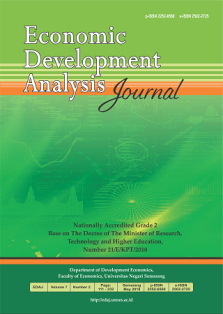Socio-Economic and Property Crime Rate in Indonesia
Abstract
This study aims to analyze the effects of socio-economic factors (inequality in income distribution, poverty, unemployment, and population) on crime rates in 31 provinces in Indonesia. The article utilizes yearly data published by the Central Bureau of Statistics (BPS-Indonesia) from 2013 to 2022. This study examines the socio-economic effects on crime rates using the two-step System Generalized Method of Moments (SYS GMM). The estimation shows that the lag in the number of property crimes positively and significantly affects property crime in Indonesia. This result indicates a dynamic relationship with the property crime rate. Moreover, poverty, unemployment, and total population positively and significantly affect short- and long-run property crime rates. However, the Gini index shows a positive correlation but lacks significance in both short- and long-term effects. These estimation results recommend that efforts be made to alleviate poverty and ensure equitable income distribution. Poverty and inequality reduction need to be pursued by all parties, especially the government, through initiatives aimed at expanding employment opportunities and sustainably empowering the community's economy.


